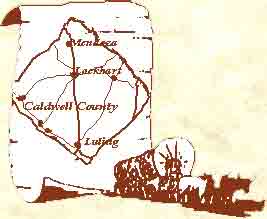
![]()

|
Mustang Ridge Most of the area residents engaged in ranching until cotton farming became
prominent about 1900. Tenant farming was common until the Great Depression, when
drought and poverty forced many struggling families to leave. Eventually,
though, ranching, although on a smaller scale, resumed and improved farming
methods have brought back some cotton.
Early schools belonged to the Creedmoor common school district, but were
consolidated with the Del Valle Independent School District in 1966. The
community of Mustang Ridge, with a population of 435, was incorporated in 1985
through the efforts of Charles and Alton Laws. With the assistance of Messrs.
Webb, Sanders, and Robertson, they established a city limit that included some
2,500 acres. By 1990, the small town included portions of northern Caldwell,
southern Travis, and southwestern Bastrop counties. Source:
Sources – The Plum Creek Almanac is a project of
The Genealogical and Historical Society of Caldwell County.
 The Genealogical and Historical Society
of Caldwell County Copyright
© 1963 The Genealogical and Historical Society
of Caldwell County Copyright
© 1963Updated 10/15/2019 |